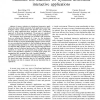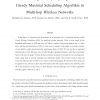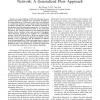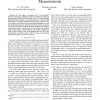INFOCOM
2008
IEEE
14 years 6 months ago
2008
IEEE
—The physical layer of future wireless networks will be based on novel radio technologies such as UWB and MIMO. One of the important capabilities of such technologies is the abil...
INFOCOM
2008
IEEE
14 years 6 months ago
2008
IEEE
Abstract—Latency reduction in distributed interactive applications has been studied intensively. Such applications may have stringent latency requirements and dynamic user groups...
INFOCOM
2008
IEEE
14 years 6 months ago
2008
IEEE
—The Peer-to-Peer (P2P) based video streaming has emerged as a promising solution for Internet video distribution. Leveraging the resource available at end users, this approach p...
INFOCOM
2008
IEEE
14 years 6 months ago
2008
IEEE
— While the practical coding scheme [1] has been shown to be able to improve throughput of wireless networks, there still lacks fundamental understanding on how the coding scheme...
INFOCOM
2008
IEEE
14 years 6 months ago
2008
IEEE
INFOCOM
2008
IEEE
14 years 6 months ago
2008
IEEE
In this paper, we characterize the performance of an important class of scheduling schemes, called Greedy Maximal Scheduling (GMS), for multi-hop wireless networks. While a lower ...
INFOCOM
2008
IEEE
14 years 6 months ago
2008
IEEE
—A unique challenge in P2P network is that the peer dynamics (departure or failure) cause unavoidable disruption to the downstream peers. While many works have been dedicated to ...
INFOCOM
2008
IEEE
14 years 6 months ago
2008
IEEE
—We use a steerable beam directional antenna mounted on a moving vehicle to localize roadside WiFi access points (APs), located outdoors or inside buildings. Localizing APs is an...
INFOCOM
2008
IEEE
14 years 6 months ago
2008
IEEE
Abstract—In order to improve scalability and reduce maintenance overhead for structured Peer-to-Peer systems, researchers design optimal architectures with constant degree and lo...
INFOCOM
2008
IEEE
14 years 6 months ago
2008
IEEE
—In this paper, we propose new “low-overhead” network monitoring techniques to detect violations of path-level QoS guarantees like end-to-end delay, loss, etc. Unlike existin...





